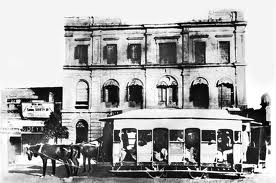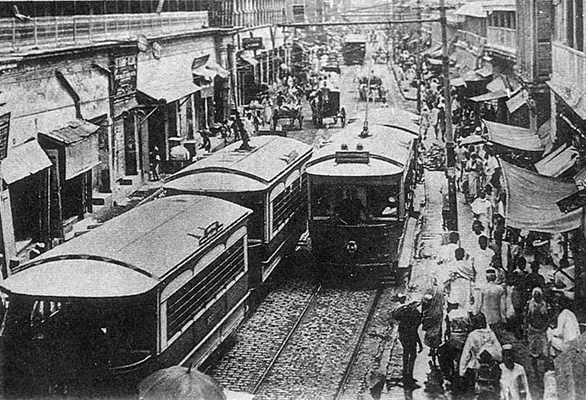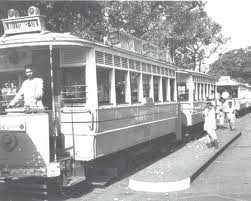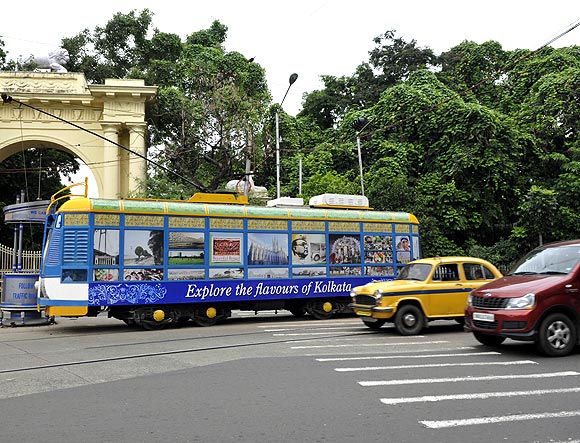Why Tramways not making headway in planned cities?
Tramways was the first mode of urban transport initially horse ridden and afterwards by electric motor. There came diesel/petrol driven vehicle which drove away the most environmental friendly mode of transport; calling Tramways unfriendly, incompatible and interference to road user”. Is it fair?
Tramways is a streamline motion on rail. There is no opportunity to overtake, never breaking the line of motion, follows the road signal system but still getting the brunt of” interference to road transport”. Road traffic is generally indiscipline in almost all the cities. With that be the situation, tram motion will certainly cause inconvenience. But had we decided that the road discipline will never improve. It will certainly one day.
I am a strong believer that Tramways has not been given a patient hearing by town planners and proposals thrown into dust bin just because it was unbundled in Mumbai, Delhi and partly in Kolkata. Why even no feasibility study?
A study conducted by Arthur D Little, a management consultant based in Boston and International Association of Public transport ranks Kolkata at 31 among 84 cities based on parameters of trips made in public transport, smart card penetration, road density, frequency of public transport and initiatives taken in the public sector. Experts say it is no surprise that Kolkata holds the top rank in the country as it has a array of options including the age-old tram system and the new age metro rail.
Metro system at Kolkata was completely renovated with rail embedded on concrete base making the system reliable and efficient.
Why Tramways abandoned?
 Following reasons emerges for abandoning tramways
Following reasons emerges for abandoning tramways
- Cities have grown haphazardly with dweller coming first and transport planned later
- Encroachment of road by hawkers making the path of tramways difficult
- Increase in road traffic density. This is particularly in heart of the cities where most of the offices and business continued.
- Easy affordability of road vehicle
- Indiscipline driving
- Inability to widen the roads
- Need to introduce one-way traffic because tramways is generally bi-directional thus causing traffic havoc..
The cities started growing outwardly but no eco-friendly transport system planned along with the development of cities.
Why not build tramways network along with road network when we are planning to habitat a population 2-5 lakhs in satellite cities. It becomes difficult when the population had already grown to the level of 5 lakhs and road network choking to build tramways network. This results a situation to go for elevated/underground metro network at an exorbitant cost of Rs. 250 Crs/Km. If the transport planners can think of spending 250 Crs/Km, 15 years later, then why no spend 10 Crs./Km for tramways network today itself. For cities like Noida, Gurgaon, or any other satellite city, metro transport system can conveniently be built at a cost of Rs. 25 Crs/Km because of need of additional underpass/over-bridge/removal of infrastructure etc. This tramways network shall connect Railway station, Airport, Inter State Bus Station, Metro Station, Interior of residential habitats etc.
The intersection distance between two metro station is around 1-3 Km and that of rapid/monorail is 1 Km. Commuters is always to depend on local transport to complete the end journeys. The local transports are rickshaw, three wheelers, chartered buses, feeder bus services etc. Tramways are the most suitable mode of transport for the end connectivity but not making inroads into the thought process of transport planners.
Introspection into Metro Project
PWC did a study on the assessment of Impact of Metro Rail System in India. Following are the salient points of the assessment:
- Delhi Metro ridership per Km increased at CAGR of 23% as network length grew at 14% CAGR.
- DMRC travel characteristics indicate behaviour of a suburban railway. This is arrived from the earning per passenger data indicates that outer stations are top earners.
- Ridership on DMRC is currently driven by users in middle-income group whereas it is lower and middle-income group in case of Mumbai Sub-urban network.
- 50% of the user of DMRC belongs to an income bracket of 10-30 k while only 13% to an income bracket of less than 10 k
- 33% of Mumbai sub-urban rail users belong to income bracket of less than 10k. This is also due to the fare structure.
- Non-users of metro offer reasons that vary based on the income levels of the segment they belong
- Personal Car User: Crowding and improper parking
- Office Vehicle: Crowding and difficulty of transfer
- Two wheeler: Access/Dispersion and no time savingPara
- Transit User: Difficulty of transfer
- Bus users Cost and Access/Dispersion
- Walk/Cycle High Cost by Metro and Access/Dispersion
Finally it is the inconvenience, Access/Dispersion and cost of travel that matters.
4. Analysis of total trip length of a metro user indicates 60% of the time is spent in access and dispersion from a metro station
-
- 70% of the average trip distance is covered by Metro and balance by Access/Dispersion
- 43% of the average trip cost is spent on Metro and balance on access/dispersion
- 39% of the average trip time is spend on Metro and balance on access/dispersion
Access and dispersion conveniences play a vital role in directing the passenger towards metro system.
Transport need of Satellite cities
Now a day’s cities are planned carefully with wider roads, population density, market hospital, parks etc. The residential areas generally never grow to the level of requiring Metro transport for its internal need or even its extension. Rapid Metro Rail in Gurgaon or Mono-rail in Mumbai is the steps in this direction. Following are the important features of the projects
| Rapid Metro Rail Gurgaon | Mono Rail Mumbai |
| PPP Model | MMRDA with consortium of L&T and Scomi engineering of Malaysian Infrastructure. |
| 5.1 Km, Six Stations | Chembur-Wadala-Jacob Circle =(8.9+10.6) 19.5 Km with 17 stations. |
| Project cost 1088 Crs i.e. Appx. 200 Crs/Km | Project Cost 2716 Crs. i.e. Appx 150 Crs./Km |
| Estimation of 2 lakhs commuters daily | 1.25 and 3 lakh passengers per day up to 2016 and 2031 respectively |
| Flat fare of Rs. 12/- | Minimum fare between Rs. 8 and Rs. 20 |
| Three Coach and 5 Trains with frequency of 4-5 minutes and average speed of 30 Km/h | Four Car and 15 trains, 3 minute headway, Average Speed of 31 Kmph |
| Rapid Metro connected to DMRC and joint ticketing | Mono Rail Mumbai connected to Mumbai Sub-urban |
| Completely elevated | Completely elevated |
Some of the important facts to be noted from this comparison
- The average distance between stations is 1 Km and again the passenger has to depend upon access/dispersion inconvenience
- Project cost is about 150 Crs./Km
- The traffic is over estimated and does not hold true when the project actually goes commercial. Rapid Metro Rail passenger traffic actually is 15% of the estimation.
The cost of construction of these metro transport system is in the range of 100-150 Crs./Km. Is it the right investment for the traffic density estimated? It is a general perception that the traffic projections are always over estimated to justify the project but never materializes in practice resulting a question mark on the financial viability of the investment. Very soon we will find no takers of the projects in PPP model and Govt. will be asked to bail out the financial need.
Why not plan tramways for feeder services?
It is not clear why tramway is not being considered for transport need of satellite cities which has a proven history of the past. Why go elevated all the time and not considering the option of tramways mos
Tramways has the distinct advantages over Metro and Bus transport system
Metro Vs Tram System
- The infrastructure cost to build may be Rs. 15 Crs. /Km much less as compared to other mode of transport to run on elevated route
- Metro transport is exclusive domain of metro train only.
- Elevated metro/mono rail/rapid rail network cannot be relocated if ever a need arises. It is possible to relocate the tram network.
- Metro provides higher average speed but for that the inter station spacing is around 1-3 Km whereas tram provide stoppage every 300-500 meter. This suits the passenger to complete the journey to his destination with only few meters to be traveled on foot.
- Tram stops in the street are easily accessible to the passenger unlike metro stations where he is to negotiate security checks, escalator/stairs etc
- The maintenance cost of Tramways is much less as compared to metro system due to very limited infrastructure
Bus Vs Tram System
- Tram and road co-exist on the same infrastructure, best example of sustainability. Infrastructural need for tramways as rail based transport system is minimal.
- Rail base transport system is energy-efficient as the train resistance of steel wheel as very low as compared to rubber tyre wheel. It is possible to regenerate power and fed back to the system during braking.
- Tram system runs on electric system, which can be sourced from renewable source of energy, a win-win situation for sustainable development.
- The track is visible, confirming the path for tramways and easily approachable by passenger
- Tram can adopt to the peak hours by adding coach
- Passenger comfort is derived where acceleration and de-acceleration is much smoother as compared to bus
- The stock is generally 2.2 meter and 16 m long and can carry 250 passengers.
- All equipment are mounted under frame with ample space for the passenger
- In order to reduce floor height, permanent magnet synchronous motor can be used conveniently. Permanent magnet synchronous motor is rugged, low weight and volume/HP, energy-efficient and most suitable for trams.
- Air Conditioning, auto-door closure makes it safe mode of transport
- Trams follow road signals. The system can be designed to have flyovers at major junctions and signalling at less a busy crossing. It can either run in the middle of the main road or at each side..
- To tackle failure, redundancy can be inbuilt. There is only one issue that of breakage of overhead wire during heavy storm for which breakdown team, ready to rush, has to be provided.
- Many European countries which in the 1950s and 1960s had discarded trams for being slow, obsolete and a source of traffic congestion are now spending millions of dollars relaying tracks and bringing back trams because they are eco-friendly, efficient and economical.
- Overhead wire may pose some problems namely
- Aesthetic of the city
- Trimming and transplantation of trees
- Tree branches falling on the overhead wire or tram panto/roof during heavy storm
This can be overcome by providing aesthetically looking poles for supporting overhead wire and growing low height trees up to 10 feet.
Noida and Greater Noida Authorities shall take a lead to have feasibility study for tramways connectivity of Noida City Center with Vaishali Metro Station and Greater Noida. Balance of Metro, tramways and Bus system shall be considered. Kolkata Tramways Corporation (CTC) is the most experienced organisation today existing in India having the experience in designing, maintaining and operating metro system in India. Why not it should come forward to market the benefits of Tramways at a very reasonable cost per kilometer.
You may also like:
- An alternative to Rapid Rail Transport Corporation for transport need…
- Addressing Safety and Security issues relating to EMU Sub-urban Services
- Mass Rapid Transit System –Suburban
- Electrical Multiple Unit – a best mode of transport
- Global Rail Technologies off the Shelf
- MRTS-Bangalore Sub-urban Rail Corporation





